Exploring Motivation Theories & Their Impact on Modern Workplace
VerifiedAdded on 2023/06/08
|7
|1942
|281
Essay
AI Summary
This essay explores the crucial role of motivation in organizations, focusing on theories such as Maslow's hierarchy of needs and Herzberg's two-factor theory. It analyzes how these theories can be applied in the modern workplace to enhance employee performance, job satisfaction, and overall organizational success. The essay highlights the importance of understanding and addressing employee needs and desires to foster a motivated workforce, leading to improved productivity and achievement of organizational goals. Examples like Tesco's application of Maslow's theory are provided to illustrate practical implementation. Desklib offers a platform to explore similar solved assignments and study resources for students.
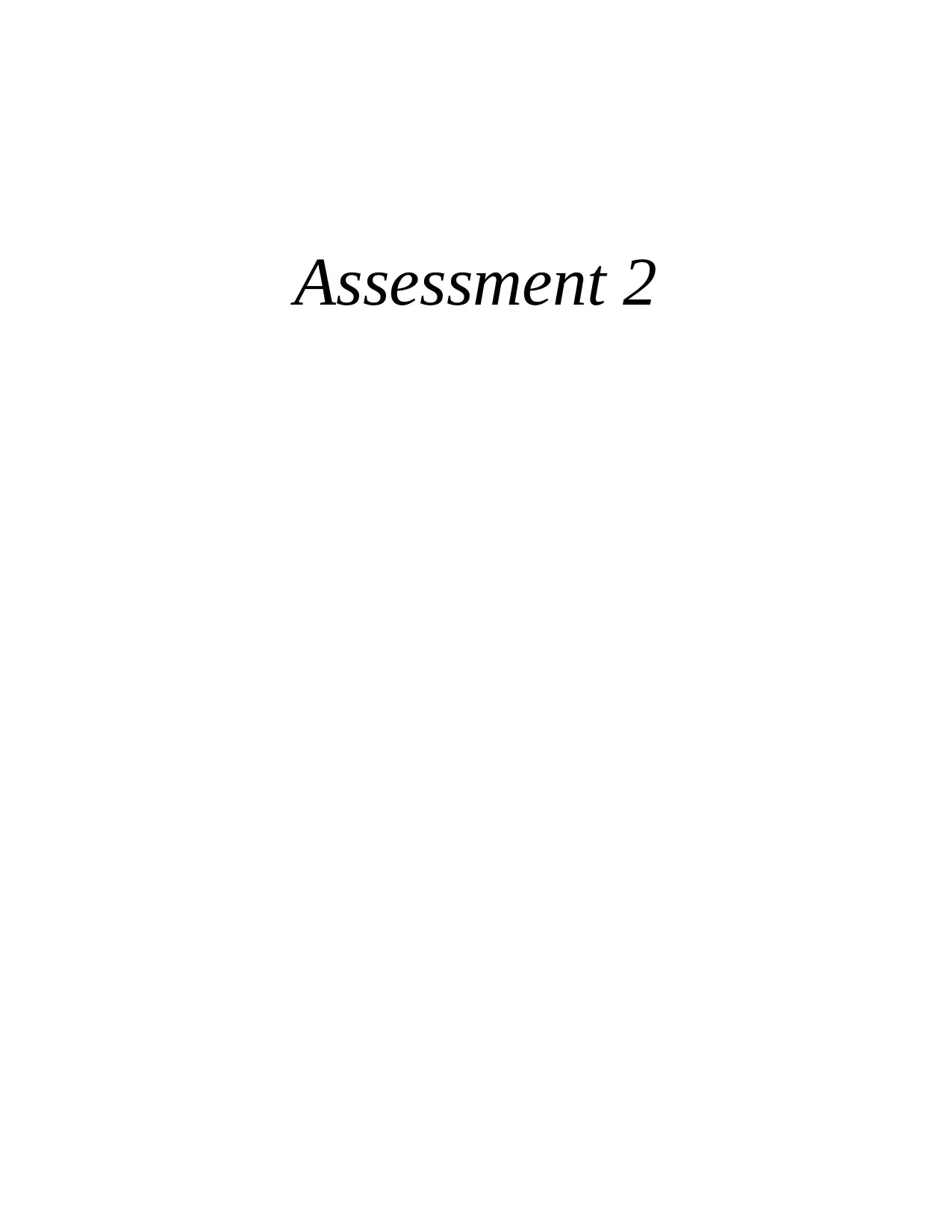
Assessment 2
Paraphrase This Document
Need a fresh take? Get an instant paraphrase of this document with our AI Paraphraser
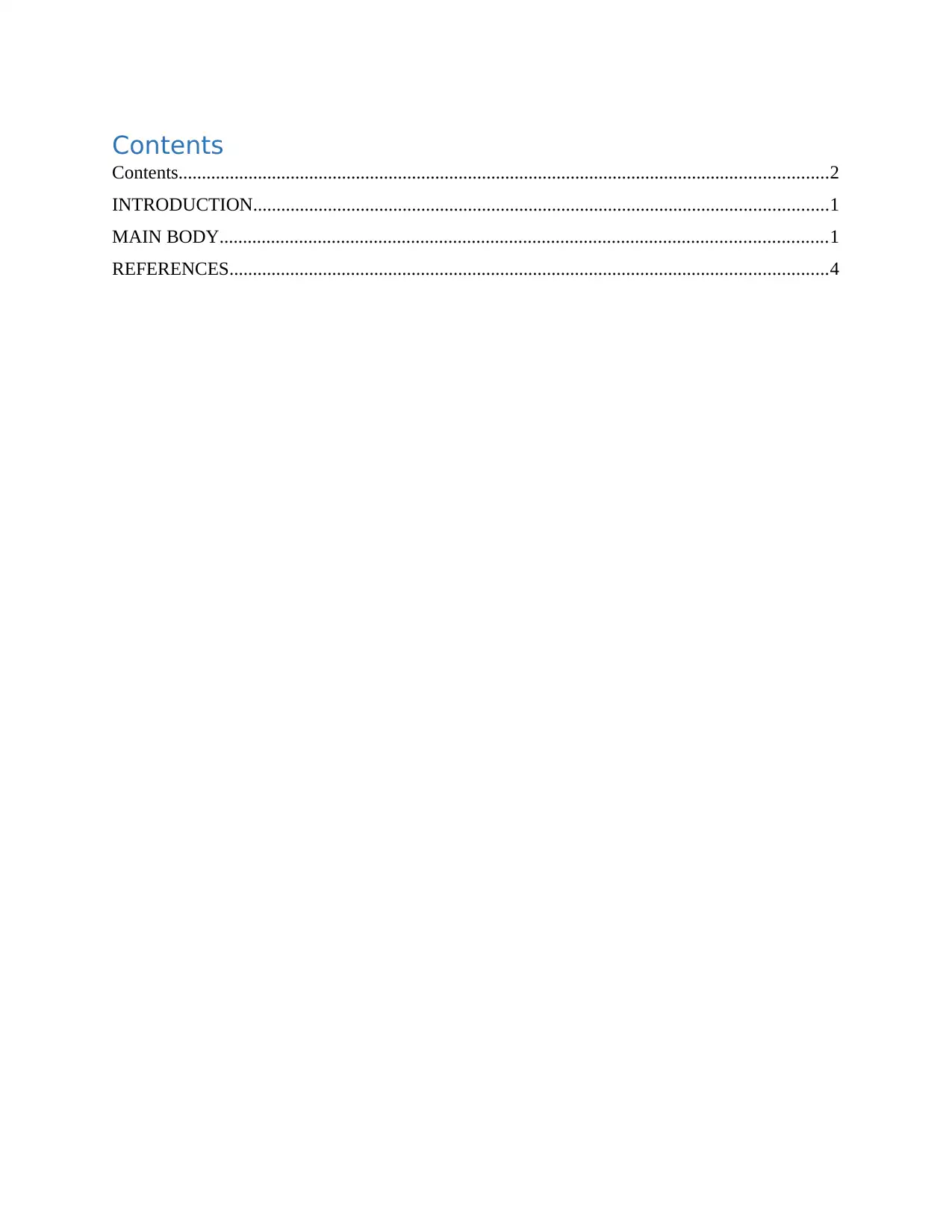
Contents
Contents...........................................................................................................................................2
INTRODUCTION...........................................................................................................................1
MAIN BODY..................................................................................................................................1
REFERENCES................................................................................................................................4
Contents...........................................................................................................................................2
INTRODUCTION...........................................................................................................................1
MAIN BODY..................................................................................................................................1
REFERENCES................................................................................................................................4
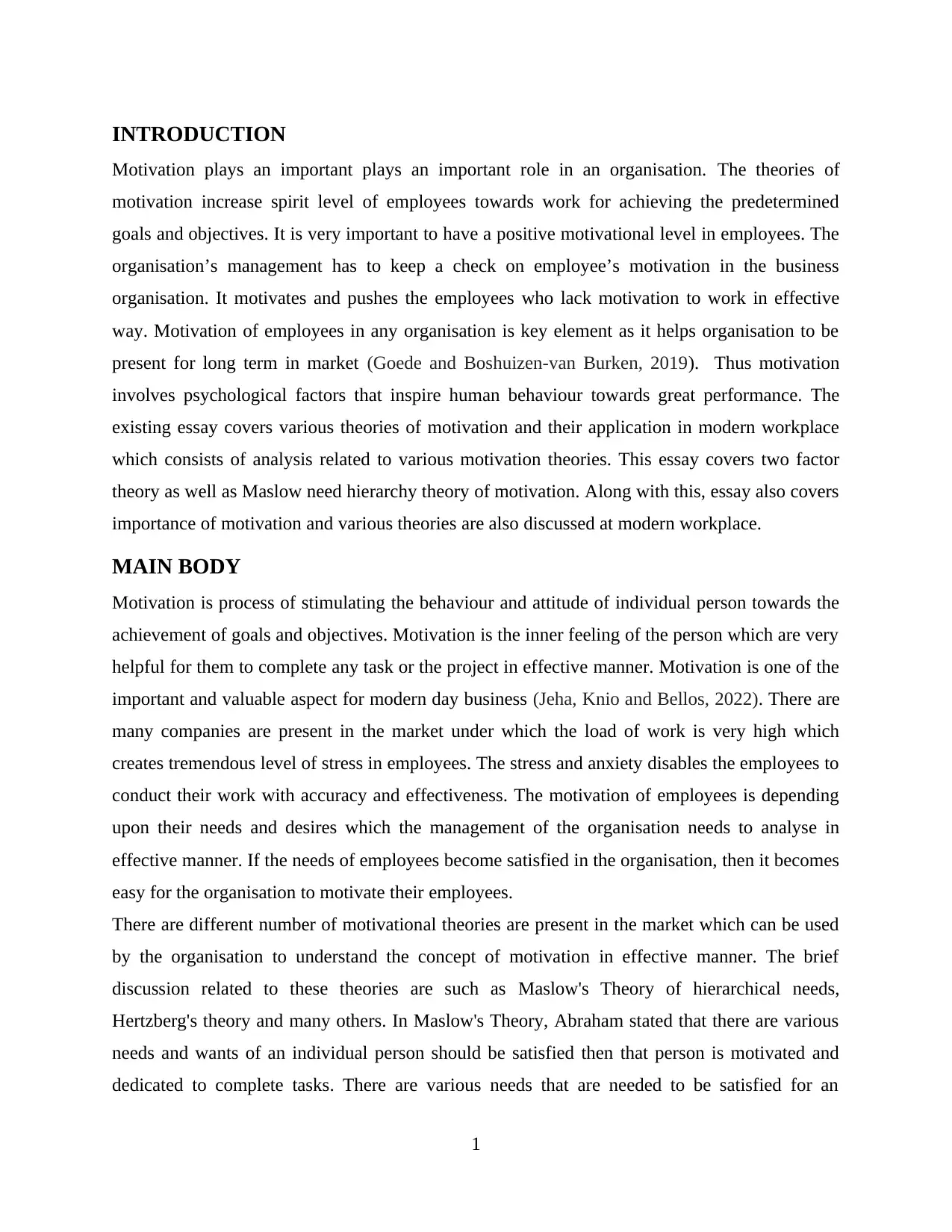
INTRODUCTION
Motivation plays an important plays an important role in an organisation. The theories of
motivation increase spirit level of employees towards work for achieving the predetermined
goals and objectives. It is very important to have a positive motivational level in employees. The
organisation’s management has to keep a check on employee’s motivation in the business
organisation. It motivates and pushes the employees who lack motivation to work in effective
way. Motivation of employees in any organisation is key element as it helps organisation to be
present for long term in market (Goede and Boshuizen‐van Burken, 2019). Thus motivation
involves psychological factors that inspire human behaviour towards great performance. The
existing essay covers various theories of motivation and their application in modern workplace
which consists of analysis related to various motivation theories. This essay covers two factor
theory as well as Maslow need hierarchy theory of motivation. Along with this, essay also covers
importance of motivation and various theories are also discussed at modern workplace.
MAIN BODY
Motivation is process of stimulating the behaviour and attitude of individual person towards the
achievement of goals and objectives. Motivation is the inner feeling of the person which are very
helpful for them to complete any task or the project in effective manner. Motivation is one of the
important and valuable aspect for modern day business (Jeha, Knio and Bellos, 2022). There are
many companies are present in the market under which the load of work is very high which
creates tremendous level of stress in employees. The stress and anxiety disables the employees to
conduct their work with accuracy and effectiveness. The motivation of employees is depending
upon their needs and desires which the management of the organisation needs to analyse in
effective manner. If the needs of employees become satisfied in the organisation, then it becomes
easy for the organisation to motivate their employees.
There are different number of motivational theories are present in the market which can be used
by the organisation to understand the concept of motivation in effective manner. The brief
discussion related to these theories are such as Maslow's Theory of hierarchical needs,
Hertzberg's theory and many others. In Maslow's Theory, Abraham stated that there are various
needs and wants of an individual person should be satisfied then that person is motivated and
dedicated to complete tasks. There are various needs that are needed to be satisfied for an
1
Motivation plays an important plays an important role in an organisation. The theories of
motivation increase spirit level of employees towards work for achieving the predetermined
goals and objectives. It is very important to have a positive motivational level in employees. The
organisation’s management has to keep a check on employee’s motivation in the business
organisation. It motivates and pushes the employees who lack motivation to work in effective
way. Motivation of employees in any organisation is key element as it helps organisation to be
present for long term in market (Goede and Boshuizen‐van Burken, 2019). Thus motivation
involves psychological factors that inspire human behaviour towards great performance. The
existing essay covers various theories of motivation and their application in modern workplace
which consists of analysis related to various motivation theories. This essay covers two factor
theory as well as Maslow need hierarchy theory of motivation. Along with this, essay also covers
importance of motivation and various theories are also discussed at modern workplace.
MAIN BODY
Motivation is process of stimulating the behaviour and attitude of individual person towards the
achievement of goals and objectives. Motivation is the inner feeling of the person which are very
helpful for them to complete any task or the project in effective manner. Motivation is one of the
important and valuable aspect for modern day business (Jeha, Knio and Bellos, 2022). There are
many companies are present in the market under which the load of work is very high which
creates tremendous level of stress in employees. The stress and anxiety disables the employees to
conduct their work with accuracy and effectiveness. The motivation of employees is depending
upon their needs and desires which the management of the organisation needs to analyse in
effective manner. If the needs of employees become satisfied in the organisation, then it becomes
easy for the organisation to motivate their employees.
There are different number of motivational theories are present in the market which can be used
by the organisation to understand the concept of motivation in effective manner. The brief
discussion related to these theories are such as Maslow's Theory of hierarchical needs,
Hertzberg's theory and many others. In Maslow's Theory, Abraham stated that there are various
needs and wants of an individual person should be satisfied then that person is motivated and
dedicated to complete tasks. There are various needs that are needed to be satisfied for an
1
⊘ This is a preview!⊘
Do you want full access?
Subscribe today to unlock all pages.

Trusted by 1+ million students worldwide
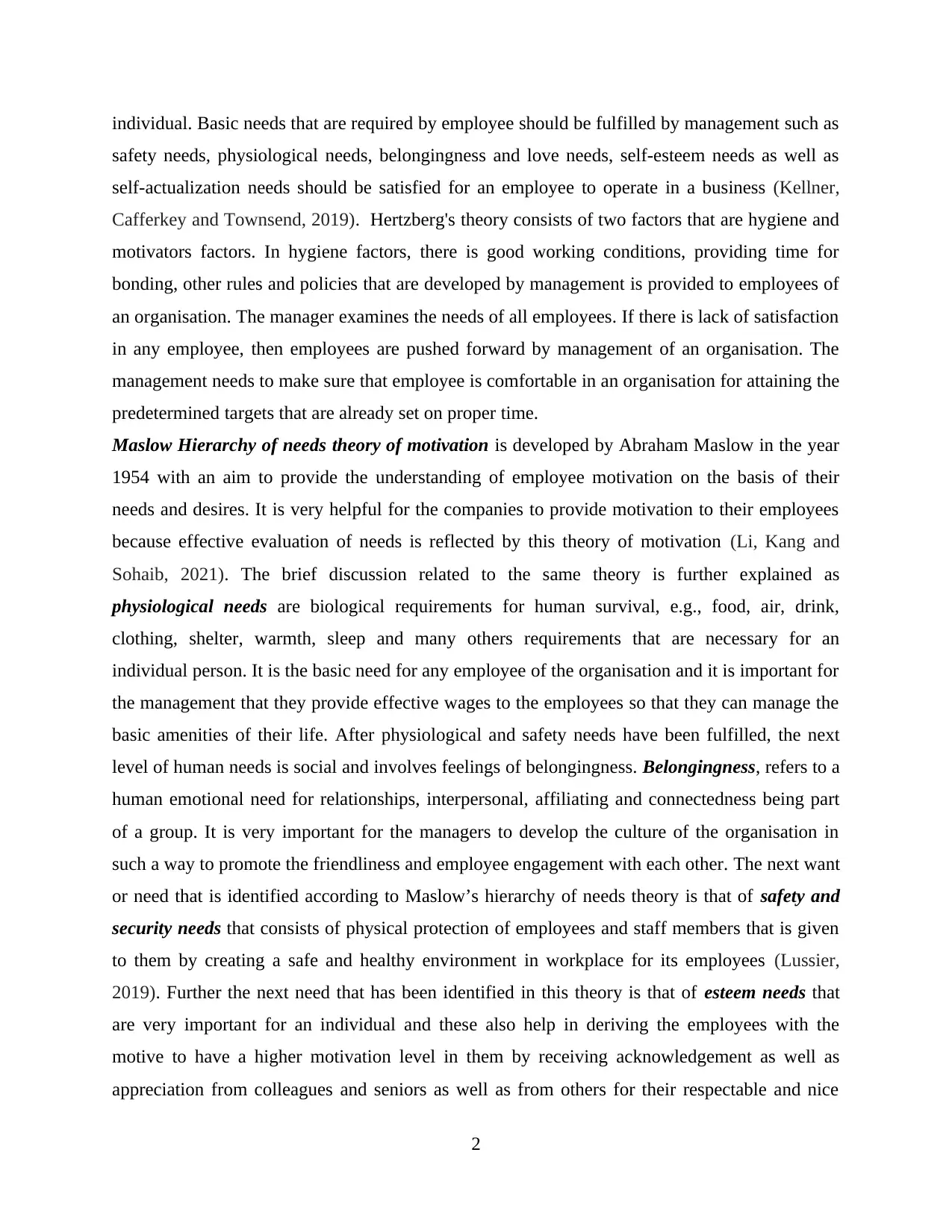
individual. Basic needs that are required by employee should be fulfilled by management such as
safety needs, physiological needs, belongingness and love needs, self-esteem needs as well as
self-actualization needs should be satisfied for an employee to operate in a business (Kellner,
Cafferkey and Townsend, 2019). Hertzberg's theory consists of two factors that are hygiene and
motivators factors. In hygiene factors, there is good working conditions, providing time for
bonding, other rules and policies that are developed by management is provided to employees of
an organisation. The manager examines the needs of all employees. If there is lack of satisfaction
in any employee, then employees are pushed forward by management of an organisation. The
management needs to make sure that employee is comfortable in an organisation for attaining the
predetermined targets that are already set on proper time.
Maslow Hierarchy of needs theory of motivation is developed by Abraham Maslow in the year
1954 with an aim to provide the understanding of employee motivation on the basis of their
needs and desires. It is very helpful for the companies to provide motivation to their employees
because effective evaluation of needs is reflected by this theory of motivation (Li, Kang and
Sohaib, 2021). The brief discussion related to the same theory is further explained as
physiological needs are biological requirements for human survival, e.g., food, air, drink,
clothing, shelter, warmth, sleep and many others requirements that are necessary for an
individual person. It is the basic need for any employee of the organisation and it is important for
the management that they provide effective wages to the employees so that they can manage the
basic amenities of their life. After physiological and safety needs have been fulfilled, the next
level of human needs is social and involves feelings of belongingness. Belongingness, refers to a
human emotional need for relationships, interpersonal, affiliating and connectedness being part
of a group. It is very important for the managers to develop the culture of the organisation in
such a way to promote the friendliness and employee engagement with each other. The next want
or need that is identified according to Maslow’s hierarchy of needs theory is that of safety and
security needs that consists of physical protection of employees and staff members that is given
to them by creating a safe and healthy environment in workplace for its employees (Lussier,
2019). Further the next need that has been identified in this theory is that of esteem needs that
are very important for an individual and these also help in deriving the employees with the
motive to have a higher motivation level in them by receiving acknowledgement as well as
appreciation from colleagues and seniors as well as from others for their respectable and nice
2
safety needs, physiological needs, belongingness and love needs, self-esteem needs as well as
self-actualization needs should be satisfied for an employee to operate in a business (Kellner,
Cafferkey and Townsend, 2019). Hertzberg's theory consists of two factors that are hygiene and
motivators factors. In hygiene factors, there is good working conditions, providing time for
bonding, other rules and policies that are developed by management is provided to employees of
an organisation. The manager examines the needs of all employees. If there is lack of satisfaction
in any employee, then employees are pushed forward by management of an organisation. The
management needs to make sure that employee is comfortable in an organisation for attaining the
predetermined targets that are already set on proper time.
Maslow Hierarchy of needs theory of motivation is developed by Abraham Maslow in the year
1954 with an aim to provide the understanding of employee motivation on the basis of their
needs and desires. It is very helpful for the companies to provide motivation to their employees
because effective evaluation of needs is reflected by this theory of motivation (Li, Kang and
Sohaib, 2021). The brief discussion related to the same theory is further explained as
physiological needs are biological requirements for human survival, e.g., food, air, drink,
clothing, shelter, warmth, sleep and many others requirements that are necessary for an
individual person. It is the basic need for any employee of the organisation and it is important for
the management that they provide effective wages to the employees so that they can manage the
basic amenities of their life. After physiological and safety needs have been fulfilled, the next
level of human needs is social and involves feelings of belongingness. Belongingness, refers to a
human emotional need for relationships, interpersonal, affiliating and connectedness being part
of a group. It is very important for the managers to develop the culture of the organisation in
such a way to promote the friendliness and employee engagement with each other. The next want
or need that is identified according to Maslow’s hierarchy of needs theory is that of safety and
security needs that consists of physical protection of employees and staff members that is given
to them by creating a safe and healthy environment in workplace for its employees (Lussier,
2019). Further the next need that has been identified in this theory is that of esteem needs that
are very important for an individual and these also help in deriving the employees with the
motive to have a higher motivation level in them by receiving acknowledgement as well as
appreciation from colleagues and seniors as well as from others for their respectable and nice
2
Paraphrase This Document
Need a fresh take? Get an instant paraphrase of this document with our AI Paraphraser
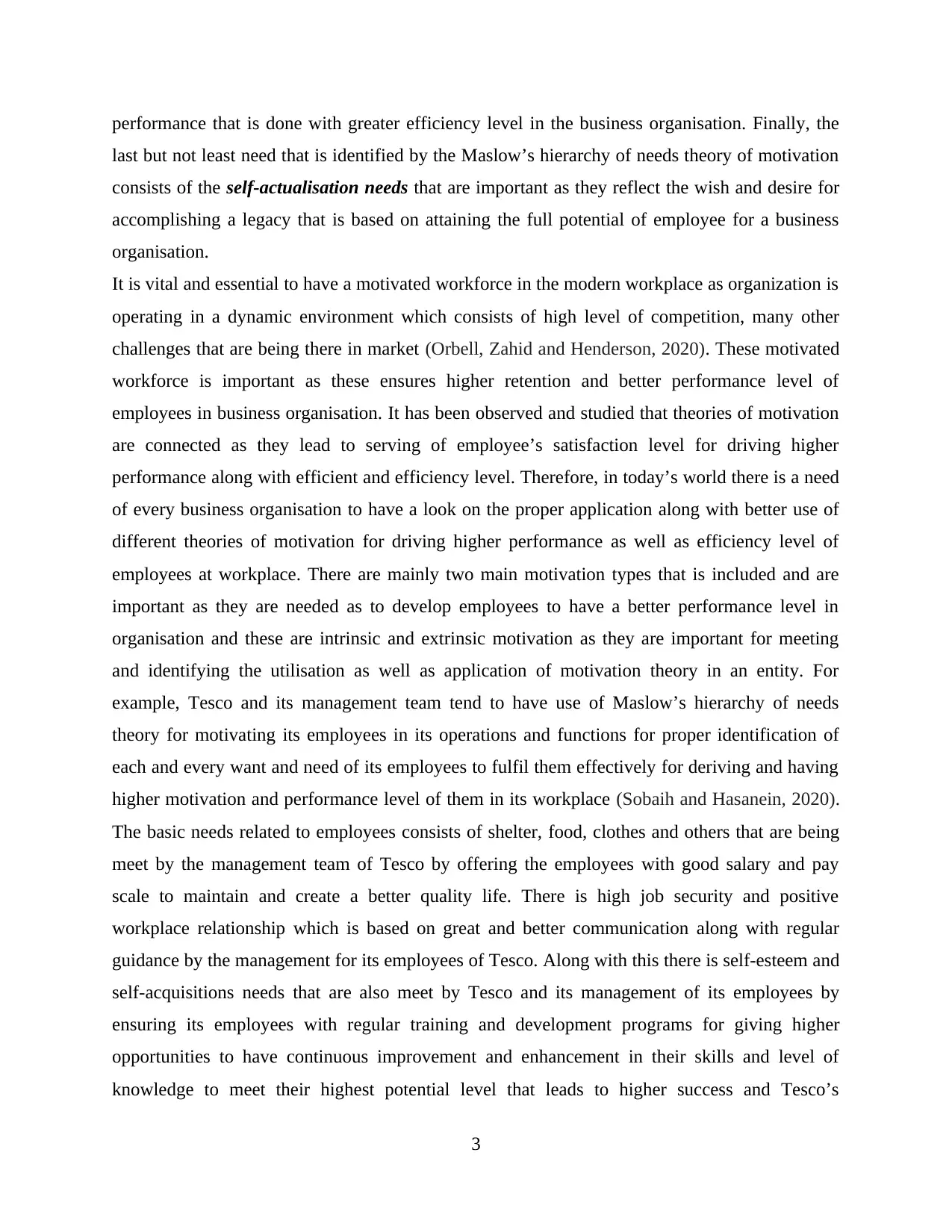
performance that is done with greater efficiency level in the business organisation. Finally, the
last but not least need that is identified by the Maslow’s hierarchy of needs theory of motivation
consists of the self-actualisation needs that are important as they reflect the wish and desire for
accomplishing a legacy that is based on attaining the full potential of employee for a business
organisation.
It is vital and essential to have a motivated workforce in the modern workplace as organization is
operating in a dynamic environment which consists of high level of competition, many other
challenges that are being there in market (Orbell, Zahid and Henderson, 2020). These motivated
workforce is important as these ensures higher retention and better performance level of
employees in business organisation. It has been observed and studied that theories of motivation
are connected as they lead to serving of employee’s satisfaction level for driving higher
performance along with efficient and efficiency level. Therefore, in today’s world there is a need
of every business organisation to have a look on the proper application along with better use of
different theories of motivation for driving higher performance as well as efficiency level of
employees at workplace. There are mainly two main motivation types that is included and are
important as they are needed as to develop employees to have a better performance level in
organisation and these are intrinsic and extrinsic motivation as they are important for meeting
and identifying the utilisation as well as application of motivation theory in an entity. For
example, Tesco and its management team tend to have use of Maslow’s hierarchy of needs
theory for motivating its employees in its operations and functions for proper identification of
each and every want and need of its employees to fulfil them effectively for deriving and having
higher motivation and performance level of them in its workplace (Sobaih and Hasanein, 2020).
The basic needs related to employees consists of shelter, food, clothes and others that are being
meet by the management team of Tesco by offering the employees with good salary and pay
scale to maintain and create a better quality life. There is high job security and positive
workplace relationship which is based on great and better communication along with regular
guidance by the management for its employees of Tesco. Along with this there is self-esteem and
self-acquisitions needs that are also meet by Tesco and its management of its employees by
ensuring its employees with regular training and development programs for giving higher
opportunities to have continuous improvement and enhancement in their skills and level of
knowledge to meet their highest potential level that leads to higher success and Tesco’s
3
last but not least need that is identified by the Maslow’s hierarchy of needs theory of motivation
consists of the self-actualisation needs that are important as they reflect the wish and desire for
accomplishing a legacy that is based on attaining the full potential of employee for a business
organisation.
It is vital and essential to have a motivated workforce in the modern workplace as organization is
operating in a dynamic environment which consists of high level of competition, many other
challenges that are being there in market (Orbell, Zahid and Henderson, 2020). These motivated
workforce is important as these ensures higher retention and better performance level of
employees in business organisation. It has been observed and studied that theories of motivation
are connected as they lead to serving of employee’s satisfaction level for driving higher
performance along with efficient and efficiency level. Therefore, in today’s world there is a need
of every business organisation to have a look on the proper application along with better use of
different theories of motivation for driving higher performance as well as efficiency level of
employees at workplace. There are mainly two main motivation types that is included and are
important as they are needed as to develop employees to have a better performance level in
organisation and these are intrinsic and extrinsic motivation as they are important for meeting
and identifying the utilisation as well as application of motivation theory in an entity. For
example, Tesco and its management team tend to have use of Maslow’s hierarchy of needs
theory for motivating its employees in its operations and functions for proper identification of
each and every want and need of its employees to fulfil them effectively for deriving and having
higher motivation and performance level of them in its workplace (Sobaih and Hasanein, 2020).
The basic needs related to employees consists of shelter, food, clothes and others that are being
meet by the management team of Tesco by offering the employees with good salary and pay
scale to maintain and create a better quality life. There is high job security and positive
workplace relationship which is based on great and better communication along with regular
guidance by the management for its employees of Tesco. Along with this there is self-esteem and
self-acquisitions needs that are also meet by Tesco and its management of its employees by
ensuring its employees with regular training and development programs for giving higher
opportunities to have continuous improvement and enhancement in their skills and level of
knowledge to meet their highest potential level that leads to higher success and Tesco’s
3
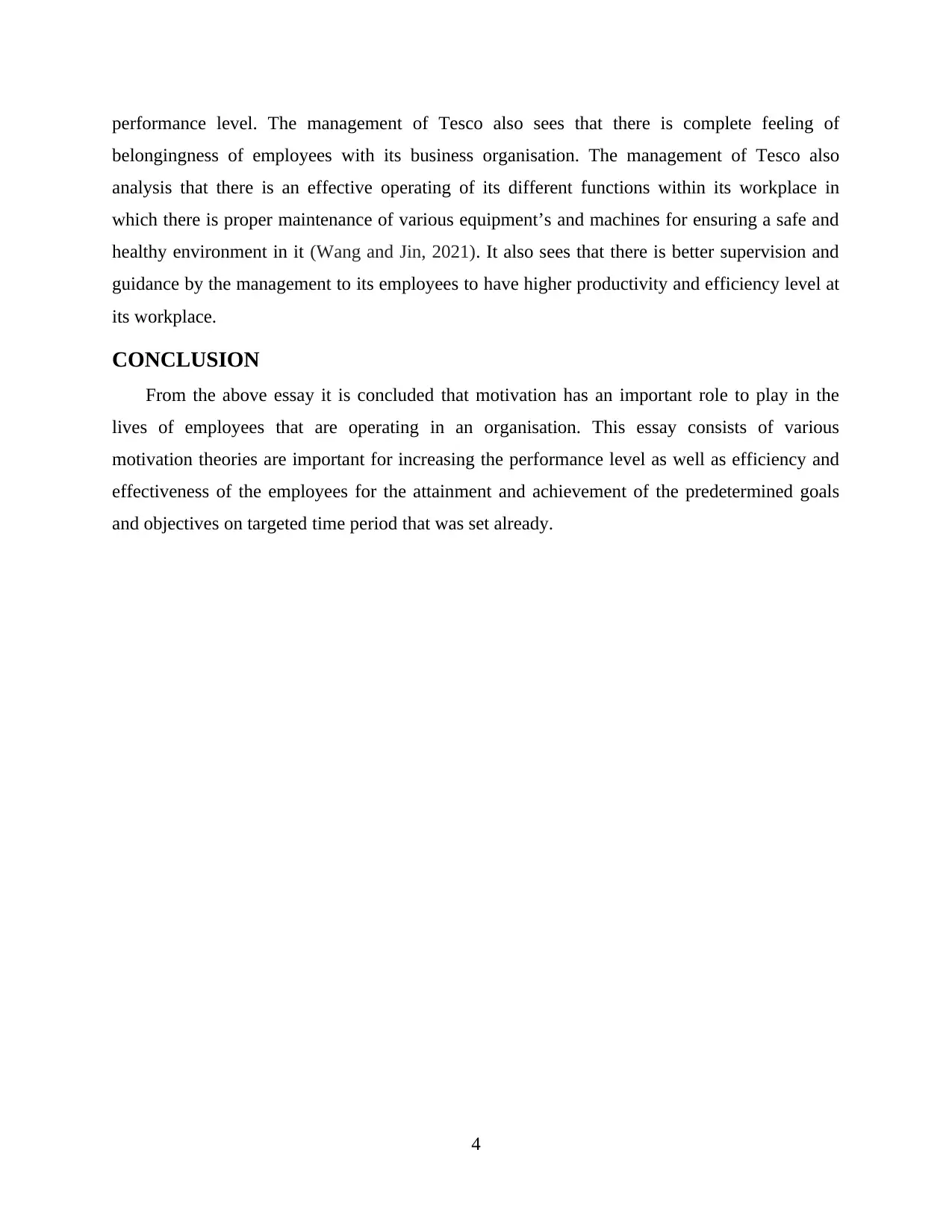
performance level. The management of Tesco also sees that there is complete feeling of
belongingness of employees with its business organisation. The management of Tesco also
analysis that there is an effective operating of its different functions within its workplace in
which there is proper maintenance of various equipment’s and machines for ensuring a safe and
healthy environment in it (Wang and Jin, 2021). It also sees that there is better supervision and
guidance by the management to its employees to have higher productivity and efficiency level at
its workplace.
CONCLUSION
From the above essay it is concluded that motivation has an important role to play in the
lives of employees that are operating in an organisation. This essay consists of various
motivation theories are important for increasing the performance level as well as efficiency and
effectiveness of the employees for the attainment and achievement of the predetermined goals
and objectives on targeted time period that was set already.
4
belongingness of employees with its business organisation. The management of Tesco also
analysis that there is an effective operating of its different functions within its workplace in
which there is proper maintenance of various equipment’s and machines for ensuring a safe and
healthy environment in it (Wang and Jin, 2021). It also sees that there is better supervision and
guidance by the management to its employees to have higher productivity and efficiency level at
its workplace.
CONCLUSION
From the above essay it is concluded that motivation has an important role to play in the
lives of employees that are operating in an organisation. This essay consists of various
motivation theories are important for increasing the performance level as well as efficiency and
effectiveness of the employees for the attainment and achievement of the predetermined goals
and objectives on targeted time period that was set already.
4
⊘ This is a preview!⊘
Do you want full access?
Subscribe today to unlock all pages.

Trusted by 1+ million students worldwide
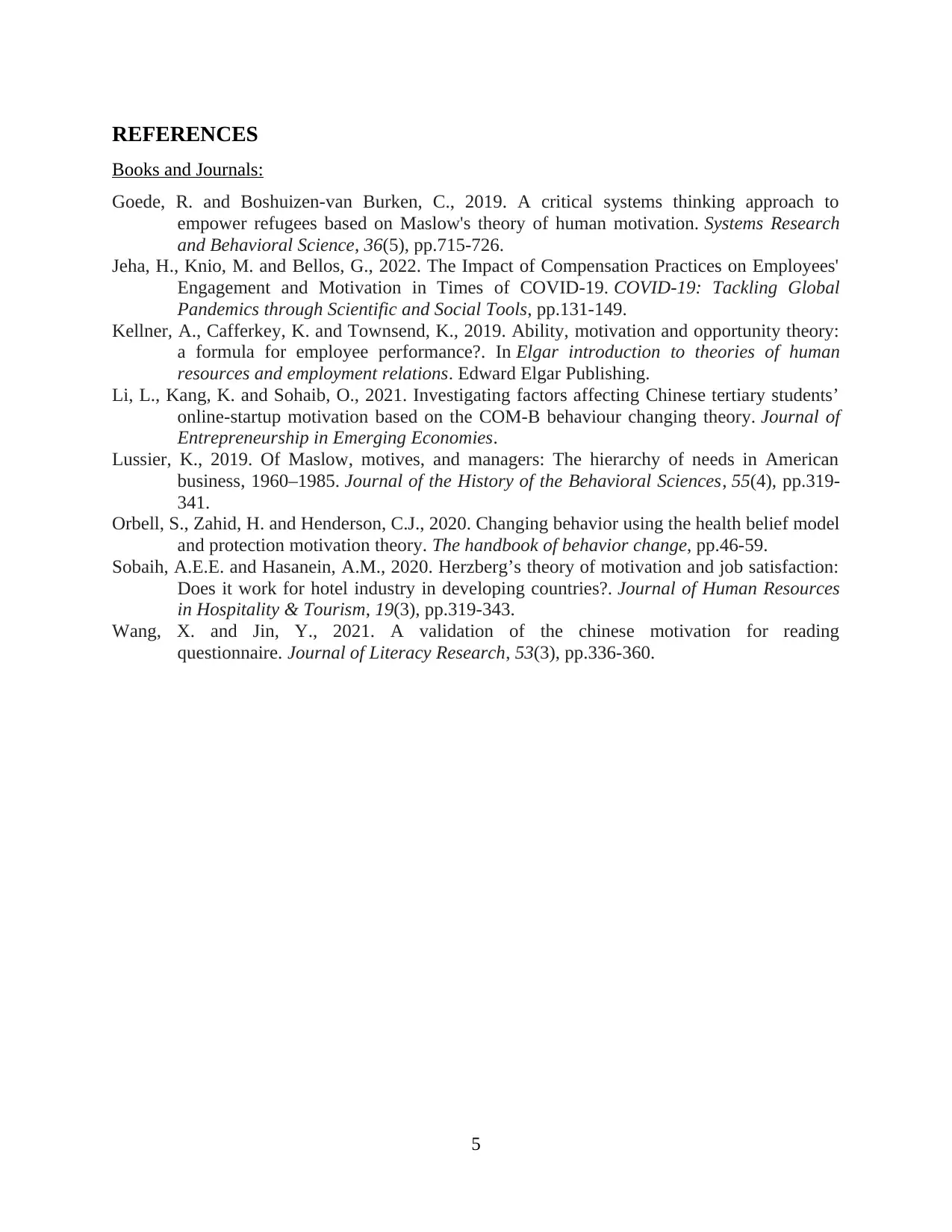
REFERENCES
Books and Journals:
Goede, R. and Boshuizen‐van Burken, C., 2019. A critical systems thinking approach to
empower refugees based on Maslow's theory of human motivation. Systems Research
and Behavioral Science, 36(5), pp.715-726.
Jeha, H., Knio, M. and Bellos, G., 2022. The Impact of Compensation Practices on Employees'
Engagement and Motivation in Times of COVID-19. COVID-19: Tackling Global
Pandemics through Scientific and Social Tools, pp.131-149.
Kellner, A., Cafferkey, K. and Townsend, K., 2019. Ability, motivation and opportunity theory:
a formula for employee performance?. In Elgar introduction to theories of human
resources and employment relations. Edward Elgar Publishing.
Li, L., Kang, K. and Sohaib, O., 2021. Investigating factors affecting Chinese tertiary students’
online-startup motivation based on the COM-B behaviour changing theory. Journal of
Entrepreneurship in Emerging Economies.
Lussier, K., 2019. Of Maslow, motives, and managers: The hierarchy of needs in American
business, 1960–1985. Journal of the History of the Behavioral Sciences, 55(4), pp.319-
341.
Orbell, S., Zahid, H. and Henderson, C.J., 2020. Changing behavior using the health belief model
and protection motivation theory. The handbook of behavior change, pp.46-59.
Sobaih, A.E.E. and Hasanein, A.M., 2020. Herzberg’s theory of motivation and job satisfaction:
Does it work for hotel industry in developing countries?. Journal of Human Resources
in Hospitality & Tourism, 19(3), pp.319-343.
Wang, X. and Jin, Y., 2021. A validation of the chinese motivation for reading
questionnaire. Journal of Literacy Research, 53(3), pp.336-360.
5
Books and Journals:
Goede, R. and Boshuizen‐van Burken, C., 2019. A critical systems thinking approach to
empower refugees based on Maslow's theory of human motivation. Systems Research
and Behavioral Science, 36(5), pp.715-726.
Jeha, H., Knio, M. and Bellos, G., 2022. The Impact of Compensation Practices on Employees'
Engagement and Motivation in Times of COVID-19. COVID-19: Tackling Global
Pandemics through Scientific and Social Tools, pp.131-149.
Kellner, A., Cafferkey, K. and Townsend, K., 2019. Ability, motivation and opportunity theory:
a formula for employee performance?. In Elgar introduction to theories of human
resources and employment relations. Edward Elgar Publishing.
Li, L., Kang, K. and Sohaib, O., 2021. Investigating factors affecting Chinese tertiary students’
online-startup motivation based on the COM-B behaviour changing theory. Journal of
Entrepreneurship in Emerging Economies.
Lussier, K., 2019. Of Maslow, motives, and managers: The hierarchy of needs in American
business, 1960–1985. Journal of the History of the Behavioral Sciences, 55(4), pp.319-
341.
Orbell, S., Zahid, H. and Henderson, C.J., 2020. Changing behavior using the health belief model
and protection motivation theory. The handbook of behavior change, pp.46-59.
Sobaih, A.E.E. and Hasanein, A.M., 2020. Herzberg’s theory of motivation and job satisfaction:
Does it work for hotel industry in developing countries?. Journal of Human Resources
in Hospitality & Tourism, 19(3), pp.319-343.
Wang, X. and Jin, Y., 2021. A validation of the chinese motivation for reading
questionnaire. Journal of Literacy Research, 53(3), pp.336-360.
5
1 out of 7
Related Documents
Your All-in-One AI-Powered Toolkit for Academic Success.
+13062052269
info@desklib.com
Available 24*7 on WhatsApp / Email
![[object Object]](/_next/static/media/star-bottom.7253800d.svg)
Unlock your academic potential
Copyright © 2020–2025 A2Z Services. All Rights Reserved. Developed and managed by ZUCOL.




